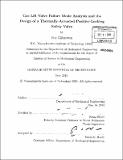| dc.contributor.advisor | Franz Hover. | en_US |
| dc.contributor.author | Gilbertson, Eric (Eric W.) | en_US |
| dc.contributor.other | Massachusetts Institute of Technology. Dept. of Mechanical Engineering. | en_US |
| dc.date.accessioned | 2011-06-20T15:58:09Z | |
| dc.date.available | 2011-06-20T15:58:09Z | |
| dc.date.copyright | 2010 | en_US |
| dc.date.issued | 2010 | en_US |
| dc.identifier.uri | http://hdl.handle.net/1721.1/64599 | |
| dc.description | Thesis (S.M.)--Massachusetts Institute of Technology, Dept. of Mechanical Engineering, 2010. | en_US |
| dc.description | Cataloged from PDF version of thesis. | en_US |
| dc.description | Includes bibliographical references (p. 131-135). | en_US |
| dc.description.abstract | Gas-lifted oil wells are susceptible to failure through malfunction of gas lift valves. This is a growing concern as offshore wells are drilled thousands of meters below the ocean floor in extreme temperature and pressure conditions and repair and monitoring become more difficult. Gas lift valves and oil well systems have been modeled but system failure modes are not well understood. In this thesis a quasi-steady-state fluid-mechanical model and a transient thermal model are constructed to study failure modes and sensitivities of a gas-lifted well system including the reservoir, two-phase flow within the tubing, and gas lift valve geometry. A set of three differential algebraic equations of the system is solved to determine the system state. Gas lift valve, two-phase flow, and reservoir models are validated with well and experimental data. Sensitivity analysis is performed on the model and sensitive parameters are identified. Failure modes of the system and parameter values that lead to failure modes are identified using Monte Carlo simulation. In particular, we find that the failure mode of backflow through the gas lift valve with a leaky check valve is sensitive to small variations in several design parameters. To address the failure modes studied, a positive-locking, thermally-actuated safety valve is designed to shut off flow through the gas lift valve in the event of failure. A prototype of the positive-locking valve is constructed and thermal actuation is tested. | en_US |
| dc.description.statementofresponsibility | by Eric Gilbertson. | en_US |
| dc.format.extent | 135 p. | en_US |
| dc.language.iso | eng | en_US |
| dc.publisher | Massachusetts Institute of Technology | en_US |
| dc.rights | M.I.T. theses are protected by
copyright. They may be viewed from this source for any purpose, but
reproduction or distribution in any format is prohibited without written
permission. See provided URL for inquiries about permission. | en_US |
| dc.rights.uri | http://dspace.mit.edu/handle/1721.1/7582 | en_US |
| dc.subject | Mechanical Engineering. | en_US |
| dc.title | Gas lift valve failure mode analysis and the design of a thermally-actuated positive-locking safety valve | en_US |
| dc.title.alternative | Design of a thermally-actuated positive-locking safety valve | en_US |
| dc.type | Thesis | en_US |
| dc.description.degree | S.M. | en_US |
| dc.contributor.department | Massachusetts Institute of Technology. Department of Mechanical Engineering | |
| dc.identifier.oclc | 727067763 | en_US |
